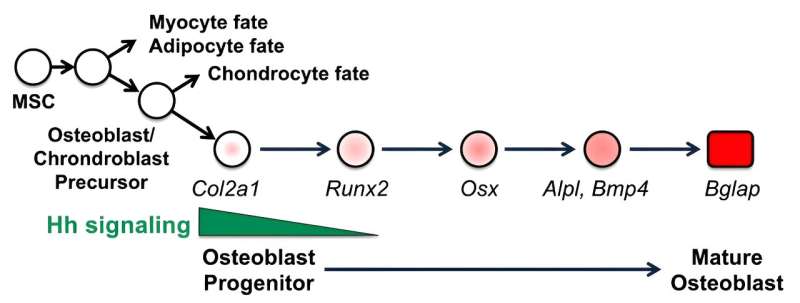Schematic depicting osteoblast differentiation annotated with expression of relevant genes. Credit: Oncogene (2023). DOI: 10.1038/s41388-023-02864-7
The strangely named hedgehog pathway that's crucial to bone growth has emerged as a key in the fight to treat the bone cancer osteosarcoma.
Osteosarcoma is a type of bone cancer that primarily affects children and young adults. It is the most common type of primary bone cancer, accounting for about 35% of all cases. Osteosarcoma is a highly aggressive cancer that can spread to other parts of the body, making osteosarcoma early detection and treatment crucial for a successful outcome.
The head of Hudson Institute's Developmental and Cancer Biology group, Dr. Jason Cain, is leading research into the potential role of hedgehog signaling in osteosarcoma. His latest research is published in the journal Oncogene.
Signaling disruption linked osteosarcoma
The hedgehog signaling pathway is crucial in the development and maintenance of tissues and organs in the body.
"The pathway plays a role in cell growth, differentiation, and survival," said Dr. Cain. "When this pathway is disrupted, it can lead to abnormal cell growth and the development of cancer."
"Recent studies have shown that hedgehog signaling may play a role in the development and progression of osteosarcoma. Over-expression of many components of the hedgehog signaling pathway, including a protein called Sonic Hedgehog (SHH), have been linked to the development and progression of osteosarcoma."
New ways to treat osteosarcoma
SHH is a protein that is involved in activation of the hedgehog signaling pathway. It is essential for the development of bones and other tissues in the body. However, when SHH is over-expressed, it can lead to uncontrolled cell growth and the development of cancer.
Lead author Dr. Vijesh Vaghjiani said the discovery of the role of hedgehog signaling has opened up possibilities for new ways to treat osteosarcoma.
"Researchers are currently exploring the therapeutic benefit of targeting this pathway to slow down or stop the growth of cancer cells," he said.
In osteosarcoma, SHH is often over-expressed, leading to the activation of the hedgehog signaling pathway. This can result in improper differentiation of normal bone forming cells and promote the growth and survival of cancer cells.
Inhibiting signaling pathway to treat osteosarcoma
"Drugs that inhibit hedgehog signaling pathway activation have been shown to be effective in other types of cancer, and studies are currently underway to determine their effectiveness in treating osteosarcoma.
"However, not all osteosarcomas show activation of the hedgehog signaling pathway and are responsive to pathway inhibitors.
"In this study, we show that loss of function mutations the tumor suppressor, TP53, are associated with increased response to SHH and activation of the hedgehog signaling pathway," Dr. Vaghjiani said.
Furthermore, osteosarcomas with loss of TP53 are responsive to hedgehog pathway inhibitor drugs, and lead to reduced tumor growth in preclinical models.
Early detection and treatment of osteosarcoma remain crucial, and individuals should consult with their doctor if they experience any symptoms or have concerns about their bone health.
Osteosarcoma facts
Osteosarcoma is a type of cancer that develops in the bones. It most commonly affects the long bones of the arms and legs, but can also occur in other bones such as the pelvis or jaw. It is mostly diagnosed in children and young adults between the ages of 10 and 30, with the average age of diagnosis being 15 years old. Osteosarcoma is currently treated with a combination of aggressive surgery and chemotherapy.
Osteosarcoma is a rare form of cancer, accounting for only 3% of all childhood cancers, but it is the most common type of bone cancer in children and adolescents.
The standard of care treatment for osteosarcoma has not changed since the 1980s and as a result, survival rates have also failed to significantly improve since this time.
The overall survival rate for osteosarcoma is approximately 70%. This means that out of every 100 people diagnosed with osteosarcoma, 70 will survive for at least five years after diagnosis. However, survival rates vary depending on the stage of the cancer at the time of diagnosis. The earlier the cancer is caught, the higher the chances of survival.
Several factors can affect the osteosarcoma survival rates, including:
- The stage of the cancer at the time of diagnosis
- The location and size of the tumor
- The type of treatment received
- The age and overall health of the patient.
More information: Vijesh G. Vaghjiani et al, Ligand-dependent hedgehog signaling maintains an undifferentiated, malignant osteosarcoma phenotype, Oncogene (2023). DOI: 10.1038/s41388-023-02864-7
Journal information: Oncogene
Provided by Hudson Institute of Medical Research
























